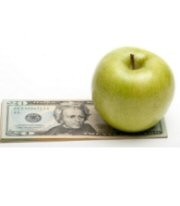USDA Organic seal grows with market, OTA survey
manufacturers are increasingly turning to the US Department of
Agriculture (USDA) Organic seal as a mark of approval, according to
the nation's Organic Trade Association (OTA).
Unveiled at the All Things Organic (ATO) trade show in Chicago in May this year, the OTA has only recently published its complete 2006 Manufacturer Survey.
According to the latest figures, the overall food organic market has grown 28 percent since 2003 to reach a total value of $14bn in 2005, and is expected to reach $16bn by the end of 2006. The figures also reveal that the organic category currently represents around 2.5 percent of all retail sales of food, with the meat category demonstrating the highest growth rate last year.
And as more and more products are added to this category, the number of manufacturers using the USDA Organic seal has also increased. Some 60 percent of the OTA Manufacturing Survey respondents said they currently display the seal on their products, while over half of those who do not currently use the seal said they planned to use it in the future.
According to the survey, 17 percent of respondents reported that USDA labeling requirements and certification programs had "dramatically increased" their ability to generate sales of organic products, while 38 percent reported that labeling increased sales somewhat, and 43 percent reported no change.
The report also reveals that more and more retail establishments are branching out into organic foods, as these become mainstream. Independent natural food chains, which laid the tracks for this category, now only account for less than a quarter of organic food sales. The largest natural food chains- led by Whole Foods Market and Wild Oats grocery retailers- represent an estimated $3.2bn of total organic food dollar sales.
But around 46 percent of organic foods were sold through the mass-market in 2005, including supermarkets and grocery stores, mass merchandisers and club stores. In total, around 900 companies sell organic foods at the wholesale level in the US.
Although currently the smallest organic category, meat, fish and poultry experienced the highest growth last year, increasing by around 55 percent to reach $256m.
According to consumer trend analyst Harvey Hartman, this is largely due to people's turn towards more 'natural' foods. Speaking at the ATO, he said consumers are increasingly opting for organic meat and dairy products in an effort to avoid hormones and antibiotics.
Indeed, the dairy sector continues to be the second largest organic category, coming in at $2bn after experiencing a 24 percent growth last year. Fruits and vegetables remain in the top spot at $5bn, with an 11 percent growth rate.
The third largest organic category is non-dairy beverages, worth $2bn and having increased 13 percent since last year. Packaged and prepared foods have shot up 19 percent to $1.8bn, while breads and grains have experienced the same growth rate and currently stand at $1.4bn.
Snack foods are up 18.3 percent to $667m, while the organic condiment market is now worth $341m, 24 percent more than last year.
Yet despite the steady growth of the organic market in the past decade, one obstacle that still remains is the lack of adequate supply. According to one industry expert, the US organic market growth is being stunted by undersupply, resulting in shelves remaining empty, companies withdrawing from the market and others looking internationally to supplement supply needs.
Indeed, over half of the OTA survey respondents reported that a lack of dependable supply of organic raw materials has restricted their company from generating more sales of organic products.
The sectors hardest hit by supply shortages are the organic orange juice, meat and dairy sectors.









